Heat moves unevenly in your outdoor oven because of three natural forces working simultaneously: conduction, convection, and radiation. The heat from your fire conducts through walls and floors while hot air rises through convection, creating temperature variations from bottom to top. Radiation from hot oven walls emits electromagnetic waves that concentrate differently throughout the space. Your oven's design, materials, and ventilation system also affect how evenly heat flows – factors like dome shape, insulation quality, and proper air circulation all play significant roles. Understanding these elements will help you master temperature control and achieve better cooking results.
Understanding Heat Movement Patterns
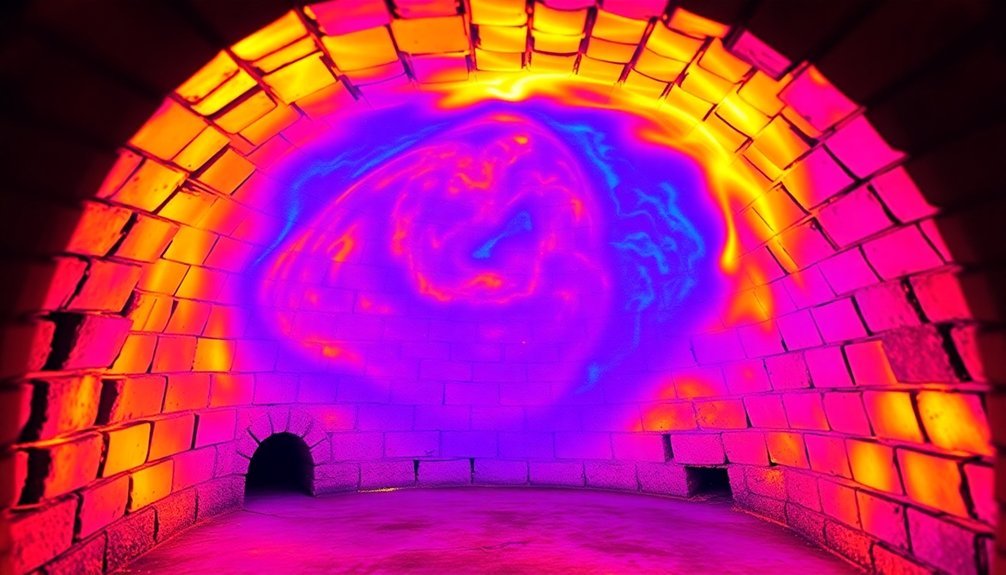
Understanding how heat moves in outdoor ovens involves three primary mechanisms: conduction, convection, and radiation.
When you're using an outdoor oven, heat transfers directly through the walls and floor to your food through conduction, while hot air moves upward through natural convection, creating temperature variations between the top and bottom of your oven.
You'll notice that radiation plays a significant role, especially at higher temperatures, as the oven walls emit electromagnetic waves that heat your food.
The internal geometry and layout of your oven affect these patterns, and you'll find that heat tends to concentrate at the top due to the vertical temperature gradient. Different baking surfaces like metal versus stone can significantly impact how heat transfers to your food.
That's why it's essential to understand these movement patterns when you're positioning your food for the best cooking results.
Design Impact on Temperature Flow
Your outdoor oven's design directly influences how heat moves and distributes throughout the cooking chamber.
The dome shape creates an ideal heat circulation pattern, while the materials you choose, from firebricks to insulation layers, determine how effectively your oven retains and radiates heat.
A properly constructed foundation not only supports the structure but also guides airflow patterns, ensuring consistent temperatures throughout the cooking process. Modern designs often incorporate horizontal-vertical airflow systems to achieve optimal temperature uniformity.
Dome Shape Maximizes Heat
When it comes to outdoor oven design, the dome shape stands as a masterpiece of thermal engineering. You'll find that this architectural choice creates the perfect environment for even cooking, as hot air naturally rises and circulates in a convection current throughout the curved space. Similar to the Pizza Dome's proven ability to generate temperatures above 700°F, this shape maximizes heat efficiency in outdoor ovens.
The dome's shape concentrates heat efficiently, allowing you to cook pizzas in just 4-8 minutes while using less fuel than other designs.
- Creates a natural convection current for uniform heat distribution
- Eliminates hot and cold spots across the cooking surface
- Reduces the need for constant pizza rotation
- Reflects heat evenly from walls to cooking surface
- Maintains structural integrity under high temperatures
The dome's effectiveness lies in its ability to direct heat precisely where it's needed, ensuring your pizzas cook evenly from crust to toppings while maintaining ideal temperature throughout the cooking process.
Materials Affect Heat Distribution
The selection of materials in outdoor oven construction plays a vital role in controlling heat distribution and cooking performance.
You'll find that materials like brick, stone, and concrete provide essential thermal mass, absorbing and releasing heat energy to maintain consistent temperatures throughout your oven.
Steel's high conductivity works alongside these refractory materials to spread heat more efficiently, while proper insulation prevents heat loss and keeps the outer shell cool.
You'll need to take into account how different materials expand when heated – the disparity between steel liners and masonry can cause structural problems if not properly addressed.
Creating uniform air layers and spacing between components is essential to avoid hot spots and maintain even heating.
With the right combination of materials, you'll achieve ideal heat distribution and cooking results.
A typical foundation requires a 3-inch reinforced concrete base to provide adequate support and thermal stability.
Foundation Directs Air Movement
Proper foundation design serves as the cornerstone of effective air movement in outdoor ovens.
You'll find that a well-constructed base, set on compacted ground, guarantees both stability and ideal heat flow. When you space your pavers correctly, air can move freely beneath the fire, creating the essential circulation needed for consistent temperatures.
- Place your base on perfectly level ground to prevent uneven heat distribution
- Install thermal breaks using perlite and concrete caps to maintain independence
- Space pavers approximately 3/4 inches apart for proper air circulation
- Create a circular or well-like foundation to promote even heat spread
- Make certain your ventilation system works in harmony with the foundation design
Your foundation's design directly impacts how heat moves through the oven, making it vital for maintaining consistent cooking temperatures and preventing unwanted hot spots.
Material Selection and Heat Transfer
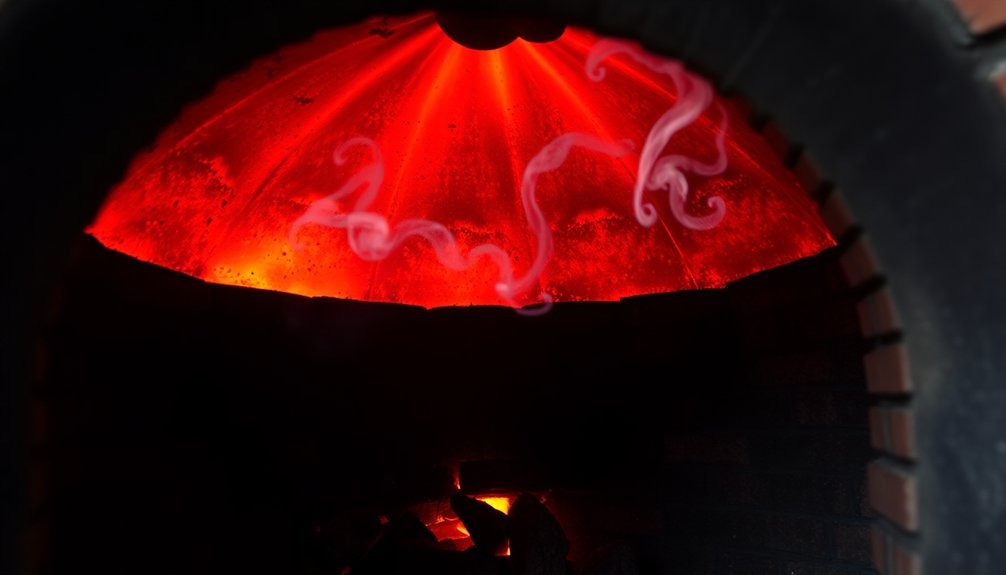
Understanding material selection in outdoor ovens requires mastering three core heat transfer mechanisms: conduction, convection, and radiation.
When you're building your oven, you'll need to balance materials that retain heat with those that insulate. Dense materials like cast iron and refractory concrete serve as thermal mass, storing and releasing heat gradually.
You'll want to layer these with insulating materials such as sand and perlite, which trap air spaces and reduce heat loss. While metals are excellent conductors, they're not ideal beneath your oven floor as they'll speed up heat transfer away from your cooking surface.
The key is creating thermal breaks using sand layers between your support slab and oven floor. This combination protects your foundation while maintaining consistent cooking temperatures through balanced heat retention and distribution.
Thermal Zones and Cooking Areas
Mastering thermal zones in your outdoor oven transforms your cooking capabilities dramatically.
Your oven's architecture creates distinct heating areas, from intense high-heat zones near the heat source to milder temperatures near the entrance. These zones aren't random – they're influenced by your oven's design, particularly its dome shape and refractory brick construction.
- High-heat zones at the back or center reach extreme temperatures, perfect for crisping crusts
- Medium-heat areas provide balanced cooking for even doneness
- Low-heat zones near the entrance help prevent overcooking
- Domed architecture maximizes natural heat circulation
- Refractory materials guarantee consistent temperature maintenance
Understanding these zones lets you control cooking precision.
You'll know exactly where to place foods for best results, whether you're seeking a crispy crust or maintaining warmth in finished dishes.
Ventilation Effects on Heat Distribution
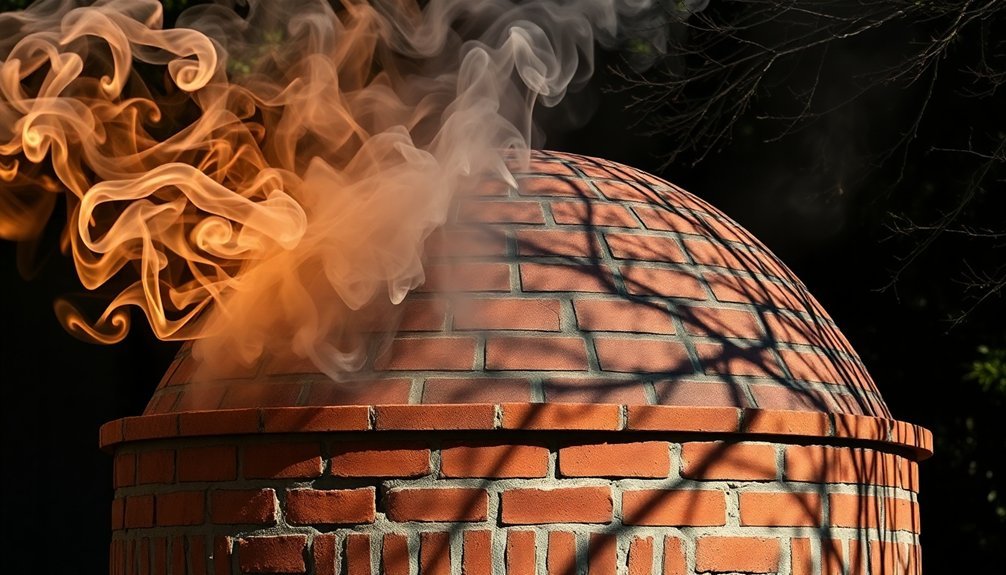
You'll find that blocked or clogged vents in your outdoor oven create problematic hot spots, leading to uneven cooking temperatures and potential safety hazards.
The way smoke flows through your oven directly impacts temperature distribution, with proper ventilation ensuring consistent heat levels throughout the cooking chamber.
Poor air circulation design can result in inefficient heat distribution and temperature control, making it essential to maintain clear, properly sized vents and well-planned airflow patterns.
Blocked Vents Create Hotspots
When outdoor oven vents become blocked with food debris, grease, or environmental contaminants, they create problematic hotspots that can ruin your cooking results.
You'll notice uneven heat distribution throughout your oven's chamber, where some areas become considerably hotter than others. This temperature inconsistency will affect your food's quality and extend cooking times as your oven struggles to maintain proper heat levels.
- Food particles and grease buildup around vents restrict essential airflow
- Temperature stratification occurs, with hot air trapped at the top
- Your baked goods may turn out dense or sunken due to disrupted heat circulation
- You'll experience higher energy costs as your oven works harder to compensate
- Blocked vents can lead to premature wear of heating elements and components
Regular cleaning and maintenance of your oven's vents will help prevent these issues and guarantee consistent cooking results.
Smoke Flow Affects Temperature
Beyond blocked vents, proper smoke flow plays a major role in maintaining consistent temperatures throughout your outdoor oven.
When your flue is too small or your chimney's too short, smoke won't draw up properly, causing it to billow out the front and create uneven heating patterns. You'll notice hot spots and cold areas that make consistent cooking impossible.
Your chimney needs adequate height and clearance to create a strong natural draw.
If there are obstructions within 10 feet of the chimney top, they'll disrupt this airflow and compromise heat distribution.
Using wet wood or cooking in a damp oven makes matters worse, as excess smoke interferes with temperature consistency.
To maintain even heating, guarantee your ventilation system's properly sized, unobstructed, and paired with well-seasoned wood.
Air Circulation Design Flaws
Common ventilation design flaws can severely impact your outdoor oven's performance, creating a cascade of heating problems.
Poor ventilation design leads to uneven heating zones and inconsistent cooking temperatures throughout your oven. You'll notice hot spots and cold areas when your oven's ventilation system isn't properly placed or sized. Additionally, blocked vents and insufficient make-up air can disrupt your oven's operation.
- Improper vent placement creates unwanted pressure differences that affect burner function
- Installing vents behind the oven wall can destabilize airflow patterns
- Blocked or undersized vents prevent proper heat distribution
- Inadequate make-up air disrupts temperature consistency
- Poor ventilation design leads to carbon monoxide buildup and safety concerns
To maintain peak performance, you'll need to guarantee your oven's ventilation system efficiently redirects smoke while maintaining consistent temperatures throughout the cooking chamber.
Heat Retention Solutions
Since maintaining consistent cooking temperatures is essential for outdoor ovens, implementing effective heat retention solutions can greatly improve their performance.
You'll want to start with proper insulation materials like ceramic fiber blankets or rock wool, applying them in layers of at least 10 cm thick. Wrap your oven dome securely with these materials and reinforce them using wire mesh.
To maximize heat retention, you'll need to combine multiple insulating elements. Install insulating fire bricks on the floor, then add calcium silicate boards for extra protection.
Mix vermiculite or perlite with cement in a 5:1 to 7:1 ratio and apply it over your ceramic fiber layer. Finally, seal everything with a protective render layer.
Don't forget to verify your door seals properly to prevent unwanted heat loss.
Maintenance for Optimal Heat Flow
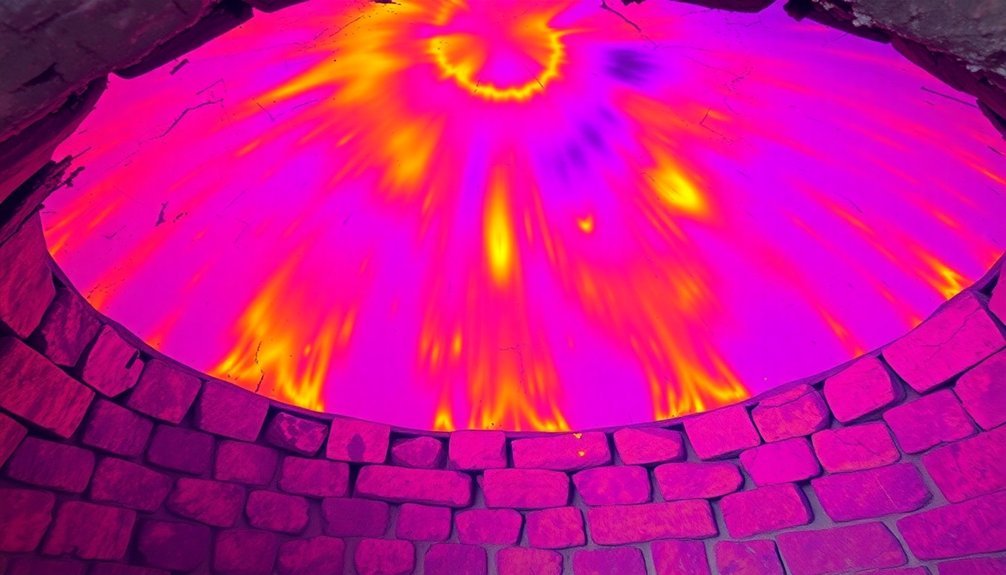
While maintaining ideal heat flow in your outdoor oven requires regular attention, a few key maintenance practices will keep it performing at its best.
You'll want to establish a routine cleaning schedule that focuses on removing obstructions that can disrupt heat distribution and compromise your oven's performance. Regular inspections of your oven's structure, including its insulation and ventilation system, are essential for consistent heat flow.
- Clean the oven floor and walls after each use to prevent heat distribution issues
- Remove ash buildup that can block proper airflow and affect temperature control
- Check the flue and chimney regularly for blockages that could impair ventilation
- Inspect insulation integrity to guarantee maximum heat retention
- Monitor the oven's structure for cracks or damage that might affect heat circulation
Frequently Asked Questions
How Does Altitude Affect Heat Distribution in Outdoor Pizza Ovens?
At high altitudes, you'll notice reduced air pressure affects your oven's heat distribution, causing faster dough rise and uneven cooking. You'll need lower temperatures and adjusted bake times to maintain consistent results.
Can Outdoor Temperature Fluctuations Damage the Oven's Internal Heating Mechanics?
Yes, outdoor temperature changes can damage your oven's heating mechanics. You'll notice moisture absorption in firebricks, freeze-thaw damage, and deteriorating insulation can all affect performance and cause long-term structural issues in your oven.
What Role Does Humidity Play in Outdoor Oven Heat Distribution?
Humidity affects your outdoor oven's heat distribution by impacting thermal transfer rates. You'll notice more uneven cooking when it's humid, as moisture in the air interferes with proper heat circulation and retention.
Should Outdoor Ovens Be Covered Between Uses to Maintain Heating Efficiency?
Yes, you should definitely cover your outdoor oven between uses. It'll help maintain heat retention, protect against weather damage, reduce fuel consumption, and keep your oven's thermal mass stable for future cooking sessions.
Do Seasonal Changes Require Different Heat Management Strategies for Outdoor Ovens?
You'll need to adapt your heat management as seasons change. Extend preheating times in winter, adjust wood amounts and damper settings, and monitor ventilation closely. Summer allows for faster heat-up and less fuel consumption.
In Summary
You'll find that uneven heat movement in outdoor ovens stems from multiple factors working together. By understanding airflow patterns, material properties, and design elements, you can better manage these temperature variations. Make sure you're maintaining proper ventilation, using appropriate materials, and regularly checking for wear. With these insights, you'll maximize your outdoor oven's performance and achieve more consistent cooking results.

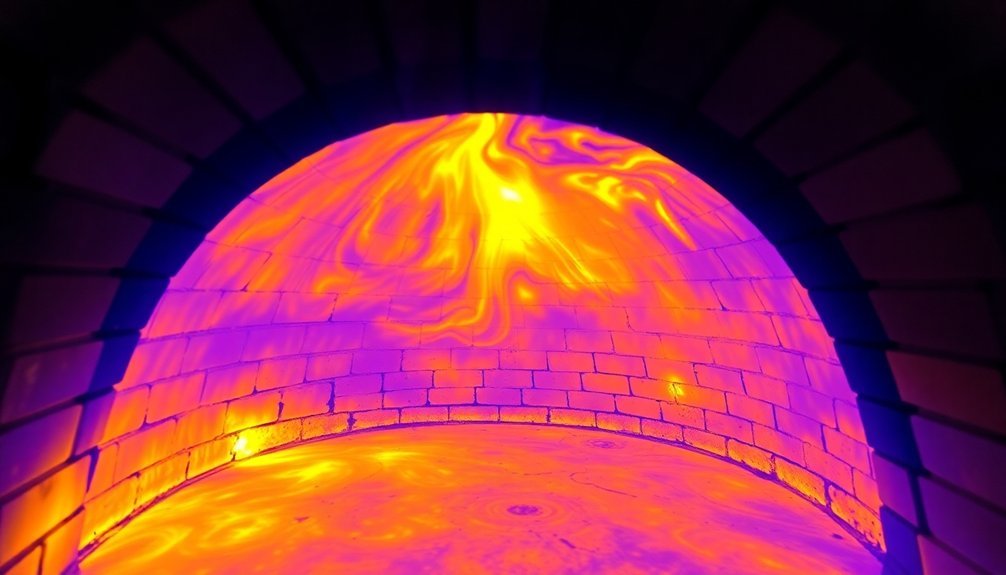



Leave a Reply